We Would Rather Not Smile
Saturday, November 21, 2009
 Even now I remember that as kid I wanted to blend in and not be noticed. I was around 9 when I was invited to the birthday party of a girl I really liked at school. It was the American Grammar School in Buenos Aires and because my mother taught there I was able to attend without paying the very high tuition. The girl was Susan Stone and her father was the CEO of General Motors Argentina. I told my mother I needed to have a pair of blue jeans. She bought me a pair that was Argentine, neither a Levis nor the more desirable Lees. I was furious and ashamed, “I am not going to that party with these. They will know.” In the end I did go as my mother explained that she did not have enough money to buy them and besides my friends were mostly American and their parents got the jeans in the US. Had I even had a pair of the real McCoys I never did blend in because I had a crooked smile. My friend made fun of my crooked smile. I decided I would never smile and when I posed for photographs I did my best not to smile. I could not make it straight. 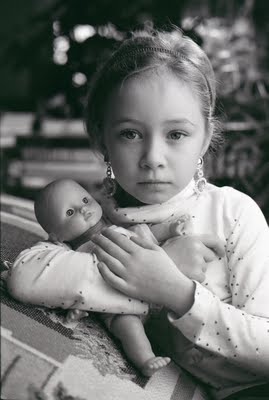 Perhaps this is the reason why I never really made my daughters smile for pictures and I continued with the idea when I started taking pictures of Rebecca. Rosemary got angry at me telling me that my pictures of an unsmiling 4-year-old were disturbing. I did not know how to counter her argument. Rebecca’s mother and family also kept asking me to take pictures of Rebecca smiling. It was about then that I figured our a relevant counter argument. I told Rosemary that I photographed Rebecca like a Victorian little girl. Victorians not only considered children to be adults they made them work long hours under terrible conditions without any consideration. I further explained that such 19th century English photographers as Julia Margaret Cameron and the Reverend Charles Lutwidge Dodgson always took portraits of children without ever making them smile. Rosemary finally gave up on me and they accepted my take on Rebecca.  Now here we have the 7-year-old Lauren who has an even more deadpan and serious expression than Rebecca. I am in my glory as I now can take pictures of another unsmiling child who will never be subjected to jeers for having a crooked smile. Yesterday we went to Lauren’s first in-progress class performance at her ballet class at Arts Umbrella. I was delighted to find out that her instructor is the remarkable modern dancer Lina Fitzner who also taught Rebecca. After the performance we braved the rain and lightning and had some crepes at the Granville Island food court. Lauren chose to have chocolate crepes. 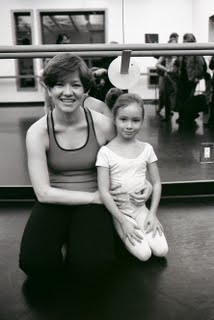 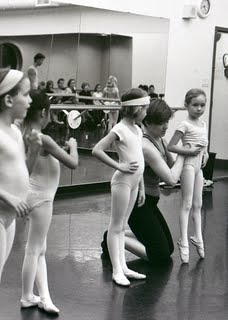 Today I continued with my “new” technique (a rediscovered one from my youth) of using Kodak Tri-X with a Nikon motor driven camera. Lauren wanted to show off her new earrings. She posed on the living room psychiatric couch with her doll Angela. I am as pleased with the pictures as Lauren is. But I am not going to smile about it. No.
Friday, November 20, 2009
 Lt. Harry Brubaker: I’m a lawyer from Denver, Colorado. Lt. Harry Brubaker: I’m a lawyer from Denver, Colorado.
Mike Forner: Judas, how'd you wind up in a smelly ditch in Korea?
Lt. Harry Brubaker: I was just asking myself that same question.
Bridges at Toko-Ri, 1954 I have much more time in my hands these days and instead of using it to read, to file photographs or perhaps find a way of fixing the ancient plumbing of our house I have been spending it in self-reflection. I have been observing the world around me and how I have changed (or not changed) in relation to it. A little incident at the downtown coffee shop on lower Granville Street, Trees Organic Coffee, yesteday, brought lots of that self-reflection, nostalgia and memories of my past. It was sometime around 1948 or 1949 (I was 6 or 7) when I accompanied my mother to a nearby ferretería (hardware store) on Hahuel Huapí Street around the corner from our house on Melián in Buenos Aires. There was something that I wanted and my mother pulled a very red and crisp peso bill (I think it was a ten peso one). She stretched it out and said to me, “Alex, what you want would take one of these and it is much too much money. I will not buy this for you until you learn the value of money.” I really did not have much of an idea of what money was and much less its value so my mother’s exercise in frugality was one I did not understand. I can still remember the sharp snap the bill made when she stretched it. At Trees I offered to pay for my coffee and Bob Mercer’s (an ex editor but still friend of mine) mate. I produced a ten dollar bill and gave it to the cashier. Just like my mother had done in BA she held it by its sides and she stretched it out. I heard the snap. Then she told me, “This is a fake bill. Do you have another one?” I didn’t so Mercer paid. I felt saddened by the sudden loss of my ten dollars. Mercer tried to console me by explaining, “What you have in your pocket is a Canadian three-dollar bill. You see I paid the five fifty and added a tip to make it seven. Since you were going to pay for it, all you have really lost is the bill you have in your pocket which is now worth three dollars.” I went home saddened by the event. As I struggle with the financially unstable profession of photography I have come to the conclusion that 61 years have elapsed since my mother told me I had to learn the value of money. It seems that not only have I yet to understand its value but I cannot even tell the real thing when I see it. But not all was lost. I turned on the TV and Robert Osborne, the evening host of Turner Classics Movies, was announcing the next feature. It was the 1954 Mark Robson film, The Bridges at Toko-Ri with William Holden, Grace Kelly, Mickey Rooney and Frederick March. The first and last time I had seen it was in 1955. I had been completely infatuated with Grace Kelly. I had been depressed by its grim, un-Hollywood ending. Even then, the film seemed bleak and the moments with Grace Kelly, too short. I am happy to report that in this second viewing the film is grittier, it seems even more authentic and it is far bleaker than I had imagined it. The brilliant young lawyer, William Holden (married to Grace Kelly and the father of two beautiful little girls) was an efficient WWII navy flier who suddenly finds himself, a recalled naval reservist who has to fly (Grumman Panther jets) over the then misunderstood "police action" (the word war was never used at the time) in Korea. Holden is befriended by his carrier admiral, the father figure Frederick March, who adopts Holden in place of the two sons he lost in the previous war. Until the end of the film you never get a glimpse of the enemy. The bombing and the strafing does not include enemy aircraft and the demolition of the bridges of the story does not show its human element. It would seem that by 1954 there was already a foreboding of future wars - a war where you pressed buttons to cause surgically sterile death and destruction. The beautiful dark blue F9F Panthers prefigured the idea of sending lone drones over Pakistan and southern Afghanistan. Both the film version and James Michener’s book, end in a stinking irrigation farm ditch in North Korea. The pilot (Holden’s plane loses its fuel in a flak hit over the secondary bombing of an ammunition dump) and his would-be helicopter rescuers die in the mud as they are besieged the appearance of the enemy at last. The soldiers, who obviously do not plan to take prisoners shoot them. The film ends there and I immediately thought that the descendants of those soldiers are putting together Hyundais and LED TV flat screen TVs. The Bridges at Toko-Ri, released two years after the first real adult western, High Noon, is in my mind the first real (American, at least) adult war film. It is a film that resonates more today that it did then. This is so because the “missions” of Afghanistan could be better equated to the “police action” of Korea and not to that war in Vietnam. In both Korea and in Afghanistan the ditches seem to be as real, as pointless and as grim. When Holden questions Frederick March as to why he (the pilot) is fighting a war (that his wife does not understand), March answers, "It's a matter of distance; we do this because we're here; back home they're only doing just as you would be doing if you were there."  Just for a few minutes as I finished here I realized that the colour of those Panthers in The Bridges at Toko-Ri is the same colour as my favourite melancholy jazz album, Miles Davis’ Kind of Blue. Both the film and the album depress me. But it is a depression that leads to self-reflection and that is not entirely bad.
Argentine Nostalgia
Thursday, November 19, 2009
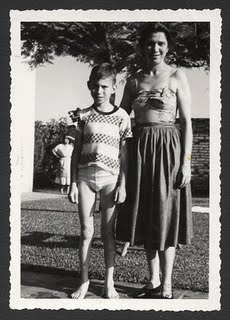
My mother kept several notebooks where she wrote love poems to the man in Manila she never married. Sometime in 1937, in a moment of impulsive fury she cast an opal ring he had given her into Manila Bay and she, her mother, sister and brother moved to Buenos Aires. My mother never let me forget that Dr. Andía, the man she never married had remained in that important corner of her heart and that my father had been a second choice. I never told her I felt like a rejected offspring of that second choice. She told me that love was action and doing and not false warmth. She rarely hugged me but she sacrificed most of her life to make enough money to send me to the best schools where I mostly squandered it by being a mediocre student who managed to cruise with not much effort. Rosemary and I had one of the more complete notebooks of poems beautifully bound in leather. The bulk of the poems is dedicated to Dr. Ramón Andía. But there is one poem that is not.
Argentine Nostalgia
I thought I’d never miss: -
The wide expanse of pasture of the pampas,
The lead gray skies & stratus clouds
The whistling, whining, violent “pamperos”,
The wet moist cold,
The hot damp heat,
The monotonous landscape
Bare of trees & bushes & human beings
Populated by lazy, cattle.
But I do,
And remember,
The balmy breezes of early spring,
The mauve of jacarandá trees in early fall,
The crisp, white frost of midwinter,
The golden yellow of the aroma in late spring
The pungent, acrid odor of the figs in midsummer.
I thought I’d never miss:
The untidy almacén at my corner
Overflowing with cellophane bags of capeletti & ravioli
And mounds of sacks of new potatoes,
Reeking of onions & “tipo Roquefort cheese”,
Of smoked ham & bacon hanging from hooks
Or:
The heated discussion of the Italian neighbours,
The chattering, singing & crying of their children,
The clatter of their plates & knives - they ate
In the patio & almost lived there,
Their plaintive singing of their summer land
And the merry quartets from Barbero & Rigoletto.
Or:
The austere grays & browns & blacks
That Porteños think proper to wear,
Their sober silence and quiet in public vehicles
The busy little sidewalk cafes under striped awnings,
The interminable wait for tram 35,
The long and never ending route it took,
But I do,
And remember:-
The exquisite taste and stark simplicity
That Porteños think proper for wear,
Their polite “permiso” as they sidled by you on colectivos
The gracious old-fashioned cadence of the
“Cuando” danced in a café.
The beautiful church on Juramento and Cabildo
I always watched out for, out of the window of Tram 35
The expectation of getting to Mother’s flat,
At the end of the line,
And the warmth I’d get there!
Filomena de Irureta Goyena de Hayward
Nueva Rosita, Coahuila, Mexico
Dec 5, 1956.

The poem is not entirely truthful in relation to sober and polite Porteños. My mother had a beautiful body and the best legs I had ever seen until I met my wife Rosemary. But in Buenos Aires she always wore a girdle. She explained to me that the Argentine men who sidled by her as she rode the colectivo (small Buenos Aires buses) had the habit of pinching her bottom with regularity. This became impossible when she wore her pinching barrier. The pampero is a wonderful wind that comes from the pampas that smells of wet earth when it is about to rain in Buenos Aires. And almacén is usually a corner grocery store which in my mother's time (and mine) was run by Italians who spoke little Spanish. The man who owned the almacén half a block from our house was called Don Pascual. Above is a jacarandá blooming in Plaza de Mayo. The building behind is the Buenos Aires cathedral. Below middle is the only slide (I took it in 1965) that I could find of a colectivo. The building behind is the seat of the president of Argentina's power, la Casa Rosada. To the left of the colectivo and above the tall entrance to the Pink House is the balcony from which Perón and his wife Evita addressed los descamisados or the shirtless ones. 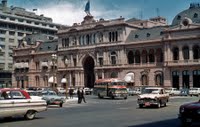
Below, right is a picture of La Redonda (The Round One) the church my mother would anticipate as she rode the Number 35 tram to her mother's flat. In one of those rare but appropriately symmetrical moments in my life I went to Mass there in 2004 with Rebecca and my godmother and first cousin Inesita O'Reilly Kuker. The Number 35 tram was long gone but there were plenty of colectivos that my mother could have ridden and looked out of the window.
 More Argentine nostalgia
And more
And even more nostalgia
More Argentine nostalgia
And more
And even more nostalgia
Argentine Nostalgia


Kyuquot, Essences & Plato's Cave Via Halsman, Sander & Stern
Wednesday, November 18, 2009
 It was sometime in 1967 that I attended a concert of the Jefferson Airplane at Fillmore West in San Francisco. I had hair down to my shoulders but I was as straight as an arrow. It was at the concert that I first began to find connections between what I had learned from Ramón Xirau in Mexico City about philosophy and in particular about Plato in relation to the reality of everyday living. It was at this concert that I spotted a young woman sitting at a corner staring at a little cocktail glass of crème de menthe. She was staring, I quickly ascertained at the greenness of the liquid. I am sure that for her the green was to ti esti, or the equivalent in English from the Greek, that what it is. She was staring at (in her imagination) absolute green, or Plato’s idea of essence. As I continued in my hobby of photography that year and began toying with the possibility of perhaps making money from it I had with me the inspiration of three photographers I admired. One was and is (he is very much alive) American Bert Stern. The other two were the Latvian Philippe Halsman and the German August Sander. I have always been attracted to their spare style and their respect for their subjects. In February 1992 I traveled to the remote community of Kyuquot, BC on Vancouver Island. I had been dispatched to teach photography for a weekend to eager students who were members of the Kyuquot Native Tribe. That weekend became a blur in my memory and when I looked at the pictures of them this morning (I am writing yesterday’s blog today, Thursday, morning) all I saw were their smiles. There were lots of smiles. They were eager to learn. Any one of those classes that I taught for the Emily Carr Outreach Program would have been a classic, “Today we are going to look at exposure and sharpness, tomorrow we will discuss the rules of composition.” Since this was before the digital revolution I took along Polaroid b+w instant 35mm slide film and a little motorized processor. My students could shoot one day and we could project the next day their results. It was fun. Last night as I was going home from six hours of teaching The Contemporary Portrait Nude and Portraiture Through the Ages at Focal Point on 10th Avenue I was shocked to realize how teaching photography has changed (from my perspective). In the nude class we have the most fantastic models (male and female) and we progress in how the nude has been seen not only in photography but in painting. Since our class is supposed to be contemporary we even had one segment where we bring in Yuliya a most interesting model that specializes in fetish. She holds a degree from Simon Fraser but in her spare time she sits on businessmen’s faces or presses her stiletto heels on their nether parts. The photo sessions in our class are tame by comparison but my students get to know a bit more than just the idea of a nude as simply a body sculpture and how parts of the body resemble dunes in the Sahara. In the other class, as an example, we projected yesterday the students’ pictures of models that we dressed up (or undressed) to resemble paintings by El Greco, John Singer Sargent and photographs by Man Ray. I finished the class by explaining that Bert Stern, in particular, had taught me (through his pictures) the idea of removing from a potential photograph all that was not necessary while retaining the essence of the person being photographed. This essence was and is that which without it the person loses his or her identity. As an example I cited Stern’s photograph of a business-suited Gary Cooper holding a Western Colt .45. The gun (and only just the gun) instantly made the man the troubled lawman of High Noon. I told my class how Halsman had almost pushed Humphrey Bogart into collapse by telling Bogart he did not want to take his picture as crook or as detective but as his essential self. Of August Sander who reverently photographed the professions (both the elites and the poor down to the beggars) of Germany for fifty years (the first half of the 20th century) I told my class that rare in this 21st century was his ability to respect the humanity of his subjects even when his subjects were members of the Nazi Party or elements of the SS. Specially troubling but beautiful were portraits of Jews taken in the late 30s who in retrospect we know vanished soon after. For Sander the essence of his subjects was the fact that they were human. I finished my class, not with an explanation of sharpness and exposure (I did delve on the idea of controlling contrast) but with a sketch on the board of Plato’s cave and an explanation of the chained men, unable to move from their stone bench, who saw "reality" projected (blurred and flickering like the fire between them and the opening to the cave at their back) on the wall in front of them. I told my students of the curious novel by José Saramago, La Caverna, where during the excavation of a mall in Lisbon, a cave is found with the remnants of charcoal, a stone bench and some chains… 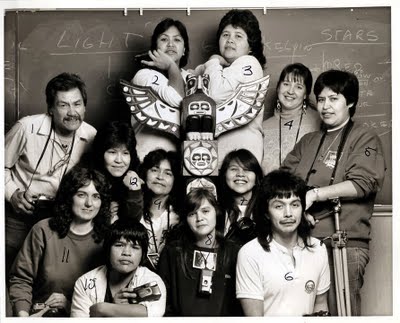 1. Eugene Leo 2. Natalie Jack 3. Anita Jack 4. Kathy Williams 5. Marilyn Short 6. Robert John 7. Bonnie Jack 8. Nancy Gillette 9. Therese Smuith 10 Warren Short 11. Ruth Zand 12 Valerie Hansen 13 Velian Vincent The smiles of my students in Kyuquot remind me of the simple and naïve world we all seemed to live in once and I now wonder how my new students will tackle the complexity of a world that seems to have forgotten the essences. Addendum: I noticed the sweater I was wearing in the picture above. I remember that I had bought it at a discount store for under $10. It was Scottish wool and it had been knit in Scoland. Just a few weeks ago I photographed Rebecca in the fall garden with the same sweater here
Waiting For Godot, Bowler Hats, Irish Pipes & Morris Panych Behaves
Tuesday, November 17, 2009
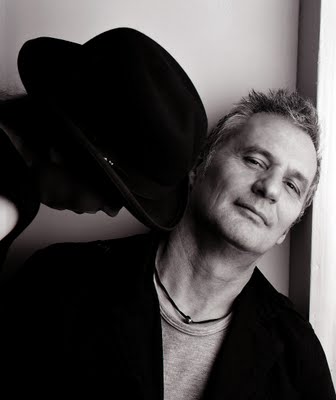 Noël Coward’s
Noël Coward’s diary entry for Saturday August 6, 1960 reads as follows:
...I have just read, very carefully, Waiting for Godot, and it is my considered opinion it is pretentious gibberish, without any claim of importance whatsoever. I know that it received great critical acclaim and I also know that it’s silly to go on saying how stupid critics are, but this really enrages me. It is nothing but phoney surrealism with occasional references to Christ and mankind. It has no form, no basic philosophy and absolutely no lucidity. It’s too conscious to be written off as mad. It’s just a waste of everybody’s time and it made me ashamed that such balls could be taken seriously for a moment…
-------------------------------------------------------------
To be frank I kind of agree with Coward and I have been bored to death the two times I saw this play. But there is one aspect of the play that always made me curious. Why is it that it always features Estragon and Vladimir wearing bowler hats? It seems that when Beckett was writing the play he had no idea of the two characters being tramps. But he is quoted as saying to French director and actor Roger Blin (who directed and acted in the first production of Waiting for Godot, on January 5, 1953) “The only thing I’m sure of is that they’re wearing bowlers.”
While researching this blog I further found out that a character in the play, Pozzo (played in the premiere showing of the play by Roger Blin) presents himself as a conceited landlord. He smokes a pipe, made by Kapp and Peterson, which are Dublin’s best known tobacconists. Their slogan was “The thinking man’s pipe,” which Pozzo refers to as briar but which Estragon calls a dudeen emphasizing the differences in their social standing. “dudeen” [Irish Gaelic dúidin, diminutive of dúd, stump, pipe] emphasizing the differences in their social standing.
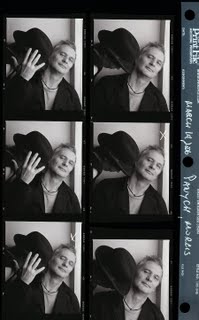 This above fact made me smile as I have written of my 10 Petersen pipes here! They were always my favourites in combination with Bell’s Three Nuns Pipe Tobacco (None Nicer!) I thought the long profile of the Petersen pipes made me look that much more sophisticated!
The whole above stuff is but a prelude to an explanation of the photograph you see here which I took March 19, 2006 of theatre director (and actor and playwright) Morris Panych. He was directing Beckett’s Waiting for Godot for the Arts Club Theatre Company at the Stanley. The Straight had dispatched me to photograph him. I was given a few minutes, between rehearsals in the lobby of the Stanley. I had no idea what I was going to do even though I had brought my big camera and my studio lights. I was met by a lovely new publicist (4 or 5 months on the job), Nicole McLuckie who had bright red hair and a most pleasant demeanor. She must have been very nervous as dealing with Panych has never been an easy thing. I decided to go for broke and asked her if she could find me a bowler hat. This she did and I took what is one of my favourite photographs ever. And Panych was uncharacteristically smooth and pleasant.
We never did decide if McLuckie was Estragon or Vladimir. But having observed McLuckie’s considerable publicist skills in the last few years, I would assert there is more of a resemblance to the assertive Vladimir.
Snow White's Evil Queen Looks At Herself In The Mirror
Monday, November 16, 2009
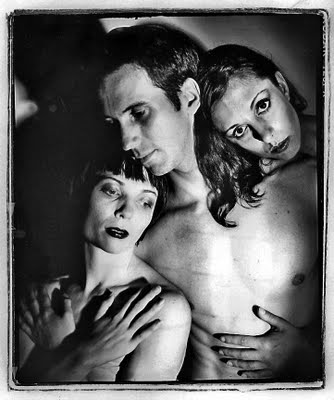 Snow White’s evil queen looking at herself in a mirror is seen as the tragic flaw that initiates a series of events that result with Snow White living happily ever after. There is a lesson here that I have wanted to teach Rebbeca. A few months ago I took a beautiful light jet print of Rebecca to Grant Simmons at Disc so that he could use it as reference for the scan, one of four that would result in my latest promotion attempt with postcards. Grant looked at the print and said, “I can do a better job than that. Leave that print behind and I will make a new one. You will see the difference.” Rebecca was bothered as we left by Simmons’ cocky faith in himself. Rebecca saw this as a flaw. She said to me, “He’s full of himself.” I was really unable to explain that when one is an artist or one has an artistic temperament the only (when money is scarce) encouragement one can have to keep at it is a faith in one’s ability. “If you think you are the best,” I told Rebecca, “you are better for it.” She was not convinced.  I did return to pick up Grant Simmons’ version of the Rebecca picture and the difference, while subtle, was overwhelming for those of us who know about correct skin tones and the keeping of texture and detail in very light areas. The print was superb. Grant Simmons is, I believe the best drum scanner in the business and his use of Photoshop is never noticed, it is that good. Snow White’s Queen, is a beautiful woman who begins to have doubts of her beauty. She must know that she is the most beautiful. This “flaw” affects models, dancers and, yes, photographers. We must know that we are good. In some cases it is not important to be told so. Deep inside, we must know by ourselves. Vancouver does not understand sustainable excellence. To be exciting you have to be a dazzling and short-lived shooting star. I remember the years of struggle that Christopher Gaze went through before he made his Bard on the Beach the success it is today. This success is now taken for granted by many and no hats are taken off to salute the man’s excellence, talent and perseverance. There are some who tell me they like this blog. They tell me they like something I wrote. For someone who is a photographer that is a very good thing to be told. To be told that the writing is okay. But is seems to me that the photographs are taken for granted. A couple of years ago someone that I don’t know sent a contact submission through this blog’s parent web page that read, “Today’s photograph of Rebecca is ugly.” I felt hurt and indignant that someone would spend the time to send me such a message. Now I am beginning to warm up to it. It means that someone was noticing the pictures. 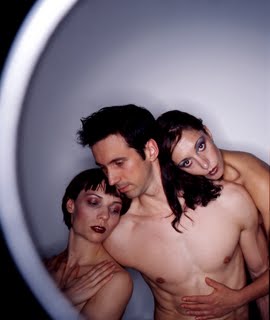 I am particularly proud (and I will have to explain to Rebecca that being proud of what one does well beats false modesty), of today’s black and white portrait. I took it for the inside of the Georgia Straight in 2005. I had been commissioned to shoot the cover which was about Ballet BC’s second mounting of its popular and racy Carmen. For the cover I used a ring flash which was positioned crooked to get that neon/ring look on the side. This happens because the camera's wide angle lens "reads" or sees the edge of the flash. The folks at the Straight could not understand it so they cropped it out.  To make things worse the dancers arrived late and had to go early. Suddenly not only did I have to shoot a cover but I had to take an inside shot that looked different. I removed the ring flash and used one low open flash fitted with a honeycomb grid that narrows the light. I took the pictures in a hurry with a very slow shutter. In spite of the stress I was satisfied with the result. The look of the picture resembles the avant-garde of the late 20s. It reminds me of a photograph taken by German photographer Herbert Bayer in 1932, above, left. I was very happy even though I didn’t get a boo from anybody. I will have to explain to Rebecca, what counts is that one knows that one took a good picture. I am proud of it. I don’t need a mirror to know that. From left to right, Acacia Schachte, Edmond Kilpatrick, Sandrine Cassini.
Ballet BC, Seriously Funny (Donald Sales) & Funny But Serious (Simone Orlando)
Sunday, November 15, 2009
 On Saturday night my granddaughters and I went to the Vancouver Dance Centre for a performance of Ballet BC's Surfacing in collaboration with the Arts Umbrella Graduate Program. It was sold out so we returned home in the rain. The silence and the disappointment in the car were palpable. Sylvain Senez, the rehearsal director, with a big smile on his face, had told me, “Why don’t you come to the 2pm matinee on Sunday?” I was not able to arrange to bring the disappointed granddaughters but I did manage to get a ticket and I even sat where I like to sit best, centre, front seat with my feet firmly planted on the dance floor! A wonderful springy floor for which the now Florentine yoga master Cornelius Fischer-Credo helped design. I sat next to a long-time dance enthusiast and dancer, Betty Kovacs whom I had not seen since I last photographed her around 1980. Part of her support of the dance community involves hosting in her house Ballet BC dancers who come from abroad. They stay with Kovacs until they find their bearings. She is also President of the Vancouver Ballet Society. 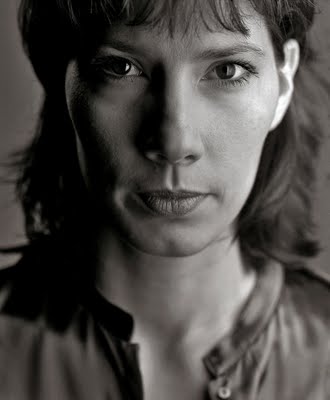 While I am sure that many of the best of Vancouver’s choreographers would have attended the opening on Friday evening and the sold out performance on Saturday night I did spot Alison Denham, Judith Garay and Jennifer Mascall. They were there for the same reason I was, to see what Ballet BC’s interim Artistic Director, Emily Molnar (right) had up her sleeve. To begin with most in the dance community in Vancouver know that Artemis Gordon’s Arts Umbrella dance program provides its students with the dream of someday, perhaps, graduating to the ranks of Ballet BC and other dance companies of renown. There were 15 Arts Umbrella dancers mingling, almost seamlessly with their Ballet BC professionals. The program did not mention that four in the ranks of Ballet BC are graduates from Gordon’s program. They were Connor Gnam (above, left), Alex Parrett, Alyson Fretz and Alexis Fletcher. The afternoon program consisted of four works by four different and local choreographers, Joe Laughlin, Simone Orlando (a Ballet BC choreographer and dancer), Donald Sales (a Ballet BC choreographer and dancer) and Rob Kitsos. On Wings, Joe Laughlin fed my almost potato chip craving for some classical en pointe walking which I sorely miss when I watch modern dance. And, of course, some Alexander Scriabin. The world needs more Alexander Scriabin. There is a lot to be said for modern dance, which I really love, but sometimes I need to experience the grace of those classically beautiful moves that are ballet and the reason why ballet, be it classical or modern, will always have a niche in contemporary dance. I am glad that Molnar had this on the program. It was my wife Rosemary who said to me when Molnar was named the interim artistic director, “Emily is going to eliminate all that classical ballet and give us only modern dance. She will fail if she does that.” 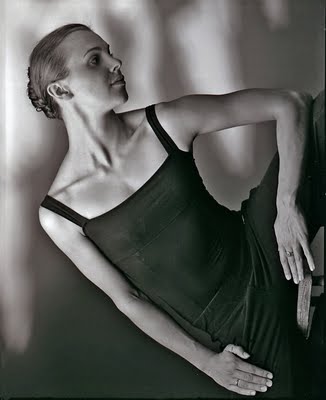 The last segment was Rob Kitsos’ Regression Line which featured very loud heavy metal/punk type music by Brooklyn’s Dub Trio. For me the saviour of the piece was the brutal performance (full of expression on her face she can change from point shoes, to pouts and sports shoes and fatigues with no problem) of the real star of Ballet BC (besides that classical ballerina Makaila Wallace) Alexis Fletcher, seen here on the left. Like her former Ballet BC dancer mate and fellow Arts Umbrella graduate, Acacia Schachte (who dances for New York’s Cedar Lake Contemporary Ballet) she has a style that is all her own. She stands out. She is not your typical cookie cutter clone that graduates from so many other ballet and dance schools. Since I am no dance critic I will gently suggest to Emily Molnar that she might want to plan in the future to bring in a couple of our best city choreographers who could progress with Kitsos’contemporary vision. Shay Kuebler (choreographer and dancer) and Amber Funk Barton (another Arts Umbrella alumnus) both have incorporated modern dance to hip hop and by fusing together the two, have come up with a dance form that is grueling, contemporary, and exciting. If Molnar is able to secure that needed funding, Jane Coop would have polished off that Scriabin sonata with aplomb and I know of a few musicians who could have adapted that Bach double violin concerto to two violins and a cello. Live music can make such an intimate dance program that much more intimate.  The two middle pieces were the ones that I really liked. I liked them because more and more I see so little humour in modern dance. In Simone Orlando’s Doppeling, John Sebastian Bach competes with Prince Valiant. It ruined my wish of seeing Arts Umbrella dancer Alexander Burton, see above, with Emily Molnar on the left and Artemis Gordon on the right), show me what he can do with so much passion. Orlando put Prince Valiant wigs on everybody, males and females and had me seriously trying to figure out who was whom and if I was supposed to laugh or not! I decided to be less serious and just enjoyed myself. It is so pleasantly surprising to see how much humour Orlando hides behind her serious face. 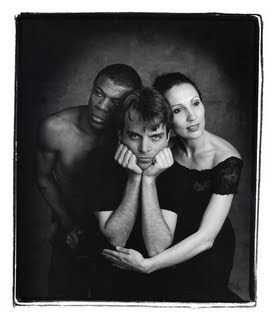 Donald Sales’ (seen in picture, right, with Simone Orlando and centre, composer Tobin Stokes whose score was used for John Alleyne's ballet A Streetcar Named Desire) Long Story Short gave me what I had come to see (besides, Alexis Fletcher, Connor Gnam and Alexander Burton) and this was the newest member of Ballet BC, Alyson Fretz. I had first seen here some five years ago telling my granddaughter Rebecca to not be distracted in a beginning ballet class. Alyson Fretz (seen below sitting with Alex Parrett standing behind her and with Arts Umbrella dancer who also helped my Rebecca pay attention, Caroline Kirkpatrick) was one of Andrea Hodge’s (ex Ballet BC dancer and dance instructor at Arts Umbrella) helpers. I have watched her grow from a little girl to the strong and muscular dancer of today (Alexis Fletcher, watch your back!). And this piece with lots of humor, lots of classy Donald Sales humor) also allowed me to observe Connor Gnam’s rare ability (one rare in so many ballet dancers) to express emotion not only with dance moves but with facial expression. 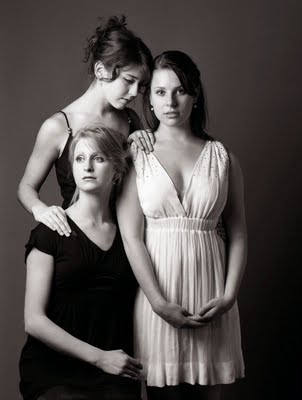 One very pleasant surprise for me was that other new Ballet BC dancer Gilbert Small, who is very black, very talented, very muscular and fun to watch. When I was waiting for the performance to begin ( I had arrived early to make sure I could buy a ticket) I spotted that other Ballet Boy from Arts Umbrella, Jed Duifhuis. I asked him, “Am I going to enjoy this?” With a big smile (he is normally stone-faced) he answered, “We are having fun so you are going to have fun.” First off there he was picking up prima ballerina Makaila Wallace and I wondered what it was like for the “student” to be on stage with such a star. Wonderful and fun, I am sure.
|


































